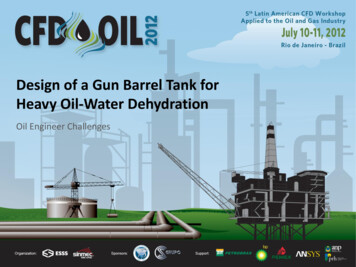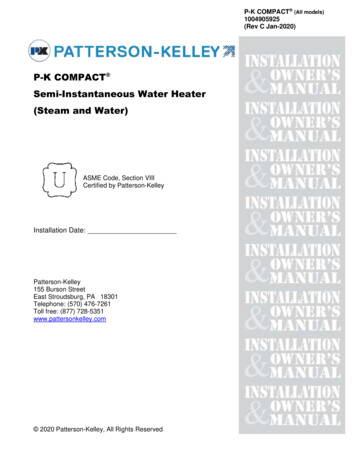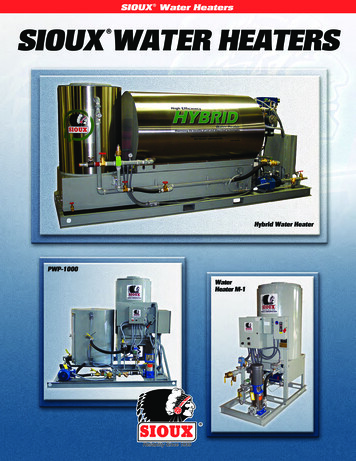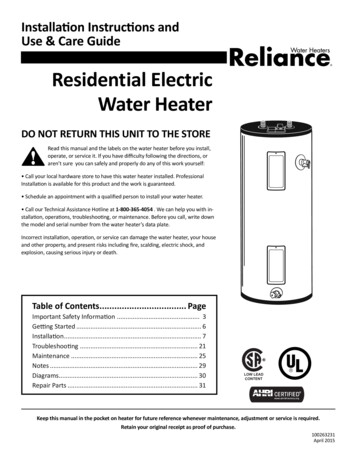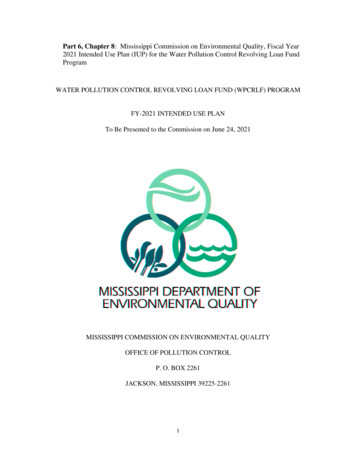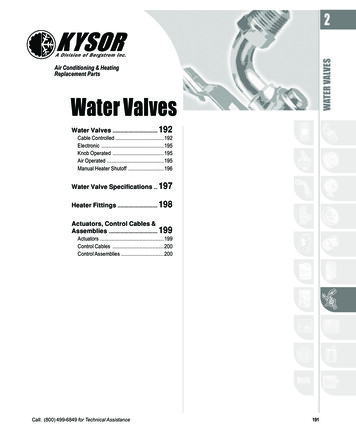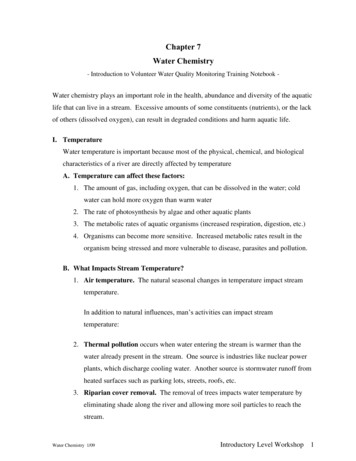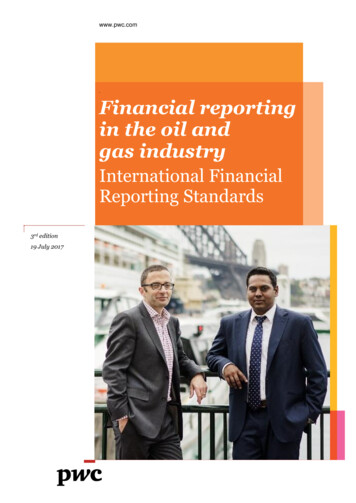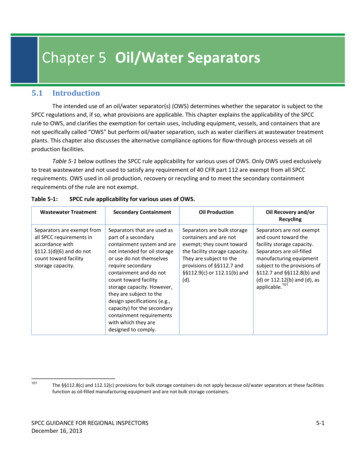
Transcription
Chapter 5 Oil/Water Separators5.1IntroductionThe intended use of an oil/water separator(s) (OWS) determines whether the separator is subject to theSPCC regulations and, if so, what provisions are applicable. This chapter explains the applicability of the SPCCrule to OWS, and clarifies the exemption for certain uses, including equipment, vessels, and containers that arenot specifically called “OWS” but perform oil/water separation, such as water clarifiers at wastewater treatmentplants. This chapter also discusses the alternative compliance options for flow-through process vessels at oilproduction facilities.Table 5-1 below outlines the SPCC rule applicability for various uses of OWS. Only OWS used exclusivelyto treat wastewater and not used to satisfy any requirement of 40 CFR part 112 are exempt from all SPCCrequirements. OWS used in oil production, recovery or recycling and to meet the secondary containmentrequirements of the rule are not exempt.Table 5-1:SPCC rule applicability for various uses of OWS.Wastewater TreatmentSecondary ContainmentOil ProductionSeparators are exempt fromall SPCC requirements inaccordance with§112.1(d)(6) and do notcount toward facilitystorage capacity.Separators that are used aspart of a secondarycontainment system and arenot intended for oil storageor use do not themselvesrequire secondarycontainment and do notcount toward facilitystorage capacity. However,they are subject to thedesign specifications (e.g.,capacity) for the secondarycontainment requirementswith which they aredesigned to comply.Separators are bulk storagecontainers and are notexempt; they count towardthe facility storage capacity.They are subject to theprovisions of §§112.7 and§§112.9(c) or 112.11(b) and(d).101Oil Recovery and/orRecyclingSeparators are not exemptand count toward thefacility storage capacity.Separators are oil-filledmanufacturing equipmentsubject to the provisions of§112.7 and §§112.8(b) and(d) or 112.12(b) and (d), as101applicable.PThe §§112.8(c) and 112.12(c) provisions for bulk storage containers do not apply because oil/water separators at these facilitiesfunction as oil-filled manufacturing equipment and are not bulk storage containers.SPCC GUIDANCE FOR REGIONAL INSPECTORSDecember 16, 20135-1
Chapter 5: Oil/Water SeparatorsThe remainder of this chapter is organized as follows:5.2 Section 5.2 summarizes applicable SPCC rule provisions to the four uses of OWS identifiedabove. Section 5.3 discusses the exemption for the use of an OWS as wastewater treatment. Section 5.4 addresses applicable SPCC requirements for the use of an OWS as secondarycontainment. Section 5.5 discusses applicable SPCC requirements for the use of an OWS at oil productionfacilities. Section 5.6 discusses applicable SPCC requirements for the use of an OWS at oil recovery orrecycling facilities. Section 5.7 describes required documentation for OWS and the role of the EPA inspector inreviewing facilities with OWS.Overview of Provisions Applicable to OWSThe following paragraphs briefly summarize the four uses of OWS and identify the SPCC provisionsapplicable to each. These requirements are discussed in greater detail in Sections 5.3 through 5.6.5.2.1 Wastewater Treatment FacilitiesSection 112.1(d)(6) of the SPCC rule addresses OWS used for wastewater treatment. Facilities orequipment used exclusively for wastewater treatment, and which do not satisfy any requirements of the SPCCrule, are exempt from the SPCC rule requirements. These OWS do not count toward facility storage capacity.Whether a wastewater treatment facility or part thereof is used exclusively for wastewater treatment or used tosatisfy an SPCC requirement will often be a facility-specific determination based upon the activities carried outat the facility and upon its configuration.5.2.2 OWS Used for Secondary ContainmentOWS used to meet the SPCC requirements for general secondary containment, sized secondarycontainment, or facility drainage are subject to applicable rule requirements, but they do not count towardstorage capacity. These include OWS that are used to meet the secondary containment requirements of§§112.7(c), 112.7(h)(1), 112.8(c)(2), 112.8(c)(11), 112.12(c)(2), and/or 112.12(c)(11). Drainage systems thatsatisfy the secondary containment requirements may use OWS to recover oil and return it to the facility (seeChapter 4: Secondary Containment and Impracticability for a description of secondary containmentrequirements). Additionally, the drainage provisions in §§112.8(b) and 112.9(b) set forth design specificationsfor secondary containment at a facility.SPCC GUIDANCE FOR REGIONAL INSPECTORSDecember 16, 20135-2
Chapter 5: Oil/Water Separators5.2.3 Oil Production FacilitiesProduction, recovery, and recycling of oil are not considered wastewater treatment and, thus, are noteligible for the wastewater treatment exemption. For purposes of §112.1(d)(6), such activities also includerecovery and recycling of crude oil at facilities associated with, and/or downstream of, production facilities, suchas saltwater disposal (produced water) and injection facilities.OWS associated with oil production activities are subject to §112.7 and applicable provisions of §112.9for onshore oil production facilities or §112.11 for offshore oil production facilities. Examples of OWS associatedwith oil production, separation, and treatment include free water knockouts, two- and three-phase separators,and gun barrels.5.2.4 Oil Recovery and/or Recycling FacilitiesOil recycling and recovery activities that collect and consolidate production fluids from multiple oilproduction facilities in an effort to further recover and treat oil prior to the disposal of production fluids are noteligible for the wastewater treatment exemption because the operations focus on oil treatment rather thanwastewater treatment. These operations typically specialize in the treatment of production fluids and other oilrecovery activities, and may include disposal and injection of production fluids. Other oil recycling operationsinclude waste oil recyclers not associated with oil production operations (e.g., motor oil recyclers) and facilitiesengaged in the recovery and/or recycling of animal fats and vegetable oils (AFVO).Figure 5-1 to Figure 5-4 illustrate rule requirements or exemptions based upon the use of OWS at SPCCregulated facilities.SPCC GUIDANCE FOR REGIONAL INSPECTORSDecember 16, 20135-3
Chapter 5: Oil/Water SeparatorsFigure 5-1:OWS subject to wastewater treatment exemption.SPCC GUIDANCE FOR REGIONAL INSPECTORSDecember 16, 20135-4
Chapter 5: Oil/Water SeparatorsFigure 5-2:OWS used to satisfy SPCC rule requirements.SPCC GUIDANCE FOR REGIONAL INSPECTORSDecember 16, 20135-5
Chapter 5: Oil/Water SeparatorsFigure 5-3:OWS at oil production facilities.SPCC GUIDANCE FOR REGIONAL INSPECTORSDecember 16, 20135-6
Chapter 5: Oil/Water SeparatorsFigure 5-4:OWS at oil recovery and/or recycling facilities.SPCC GUIDANCE FOR REGIONAL INSPECTORSDecember 16, 20135-7
Chapter 5: Oil/Water Separators5.3OWS Used for Wastewater Treatment5.3.1 OWS Used for Wastewater TreatmentOWS used to pre-treat wastewater are typically standard gravity or enhanced gravity separators.102Standard gravity separators, as illustrated in Figure 5-5 (separator designs may vary), are liquid containmentstructures that provide sufficient hydraulic retention time to allow oil droplets to rise to the surface. The oilforms a separate layer that can then be removed by skimmers, pumps, or other methods. The wastewater outletis located below the oil level so that water leaving the separator is free of the oil that accumulates at the top ofthe unit. The inlet is often fitted with diffusion baffles to reduce turbulent flow that might prevent effectiveseparation of the oil and might re-suspend settled pollutants.PFigure 5-5:PStandard gravity oil/water separator.Enhanced gravity separators allow the separation of smaller oil droplets within confined spaces. Theseseparators use a variety of coalescing media and small diameter cartridges that enhance laminar flow andseparation of smaller oil droplets that accumulate on the separator surface for removal. Figure 5-6 showscoalescing plates in the middle compartment (separator designs may vary).102Other types of separators include vortex separators, which combine gravity with centrifugal forces.SPCC GUIDANCE FOR REGIONAL INSPECTORSDecember 16, 20135-8
Chapter 5: Oil/Water SeparatorsFigure 5-6:Enhanced gravity oil/water separator.OWS are flow-through equipment in which wastewater enters the separator and treated water exits theseparator typically on a continual basis. To be effective, the OWS is sized appropriately in order for the unit toseparate and contain the intended oil capacity, in addition to the flow-through wastewater quantity. Also, thedesign flow rate of the OWS is carefully considered when specifying a wastewater treatment system, as a flowrate above the maximum rate of the separator will cause the discharge of accumulated oil and/or untreatedwastewater. The specifications from OWS manufacturers typically outline these and other design factors andconsiderations, along with operation and maintenance requirements, to ensure that the OWS is correctlyconstructed and operated for its intended use.5.3.2 Applicability of the SPCC Rule to OWS Used for Wastewater TreatmentSection 112.1(d)(6) exempts “any facility or part thereof” that is used exclusively for wastewatertreatment and is not used to meet any other requirement of the rule (excluding oil production, recovery, andrecycling facilities). There are components of wastewater treatment facilities, such as treatment systems atpublicly owned treatment works (POTWs) and industrial wastewater treatment facilities treating oilywastewater, that likely meet the two criteria for this exemption. OWS used exclusively for wastewatertreatment are flow-through separators and are not engaged in a static process in an isolated container. Forexample, the presence of a water sump in a bulk storage container does not constitute wastewater treatment.POTWs and other wastewater treatment facilities may have bulk storage containers and oil-filledequipment, as well as exempt OWS. The capacities of the bulk storage containers and oil-filled equipment arecounted to determine whether the facility is subject to the requirements of the SPCC rule. The presence of anOWS at an otherwise regulated facility does not exempt the entire facility from the SPCC rule requirements.Such OWS capacity does not count toward the overall storage capacity of the facility, and only that equipmentused for oil/water separation is not subject to any rule provisions. At wastewater treatment facilities, storagecapacities to be counted include bulk storage containers, hydraulic equipment associated with the treatmentprocess, containers used to store oil that feed an emergency generator associated with wastewater treatment,and slop tanks or other containers used to store oil resulting from treatment. All separate containers used toSPCC GUIDANCE FOR REGIONAL INSPECTORSDecember 16, 20135-9
Chapter 5: Oil/Water Separatorsstore oil recovered by the separation process and all other equipment or containers at a regulated facility thatdo not qualify for the wastewater treatment exemption are required to meet the applicable SPCC requirements(67 FR 47069, July 17, 2002).Examples of wastewater treatment OWS that may be eligible for the exemption of §112.1(d)(6) include: OWS at a wastewater treatment facility; OWS at an active groundwater remediation site; Grease traps that intercept and congeal oil and grease from liquid waste; and OWS in landfill leachate collection systems.A separate container storing oil removed from an exempt separator is considered a bulk storagecontainer and is subject to the SPCC rule requirements. Furthermore, OWS exempted from the SPCC rule may besubject to other federal, state, and local regulations. For example, many exempted wastewater treatment OWSare within wastewater treatment facilities or parts thereof subject to the National Pollutant DischargeElimination System (NPDES) requirements under section 402 of the Clean Water Act (CWA). NPDES (or anapproved state permit program) ensures review and approval of the facility’s wastewater treatment plans andspecifications, as well as operation/maintenance manuals and procedures, and requires a Storm Water PollutionPrevention Plan, which may include a Best Management Practice (BMP) Plan.103PAdditionally, some facilities may be subject to pretreatment standards promulgated under §307(b) ofthe CWA. Pretreatment standards apply to “indirect discharges” that go first to a POTW via a collection systembefore being discharged to navigable waters. The General Pretreatment Regulations for Existing or New Sourcesof Pollution, found at 40 CFR part 403, prohibits an indirect discharger from introducing into a POTW a pollutantthat passes through or interferes with treatment processes at the POTW, and also sets the framework for theimplementation of categorical pretreatment standards. Specifically, 40 CFR 403.5(b)(6) prohibits theintroduction into a POTW of “petroleum, oil, non-biodegradable cutting oil, or products of mineral oil origin inamounts that will cause interference or pass through.”103BMPs are operational conditions that may supplement or constitute effluent limitations in NPDES permits. Under §402(a)(2) ofCWA, BMPs may be imposed in addition to effluent limits when the EPA Administrator determines that such conditions arenecessary to carry out the provisions of the Act. See discussion of authority for NPDES and BMP provisions in the preamble tothe 2002 final SPCC rule, 67 FR 47068.SPCC GUIDANCE FOR REGIONAL INSPECTORSDecember 16, 20135-10
Chapter 5: Oil/Water SeparatorsExample of SPCC Rule Applicability and Secondary Containment Requirements: Kitchen Grease TrapA kitchen grease trap at a facility otherwise subject to the S
The intended use of an oil/water separator(s) (OWS) determines whether the separator is subject to the SPCC regulations and, if so, what provisions are applicable. This chapter explains the applicability of the SPCC rule to OWS, and clarifies the exemption for certain uses, including equipment, vessels, and containers that are not specifically called OWS but perform oil/water separation, such .


